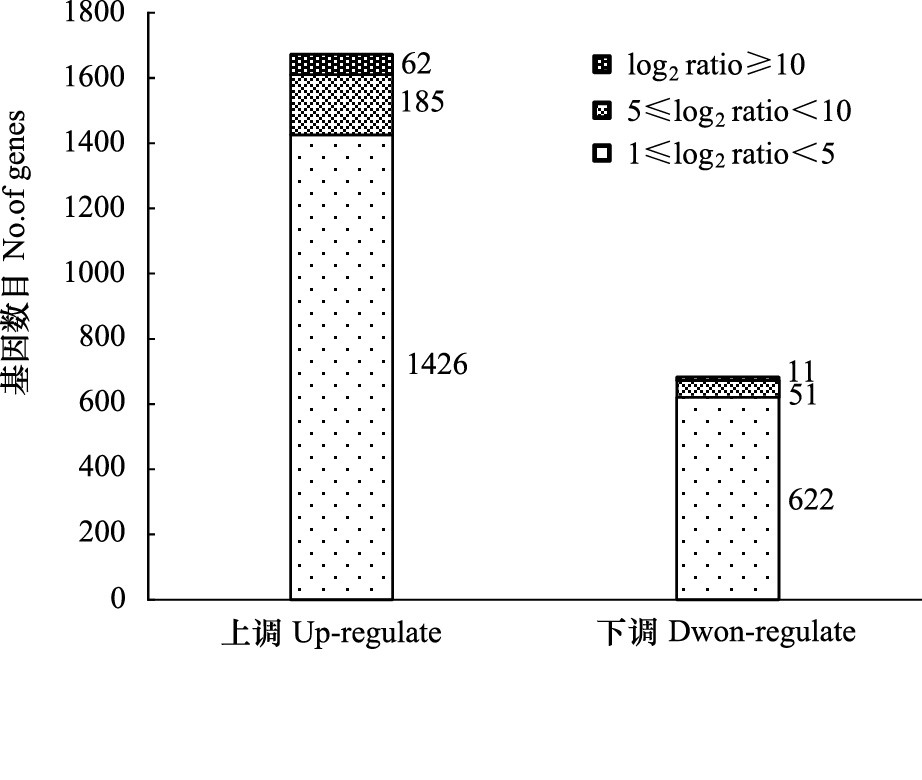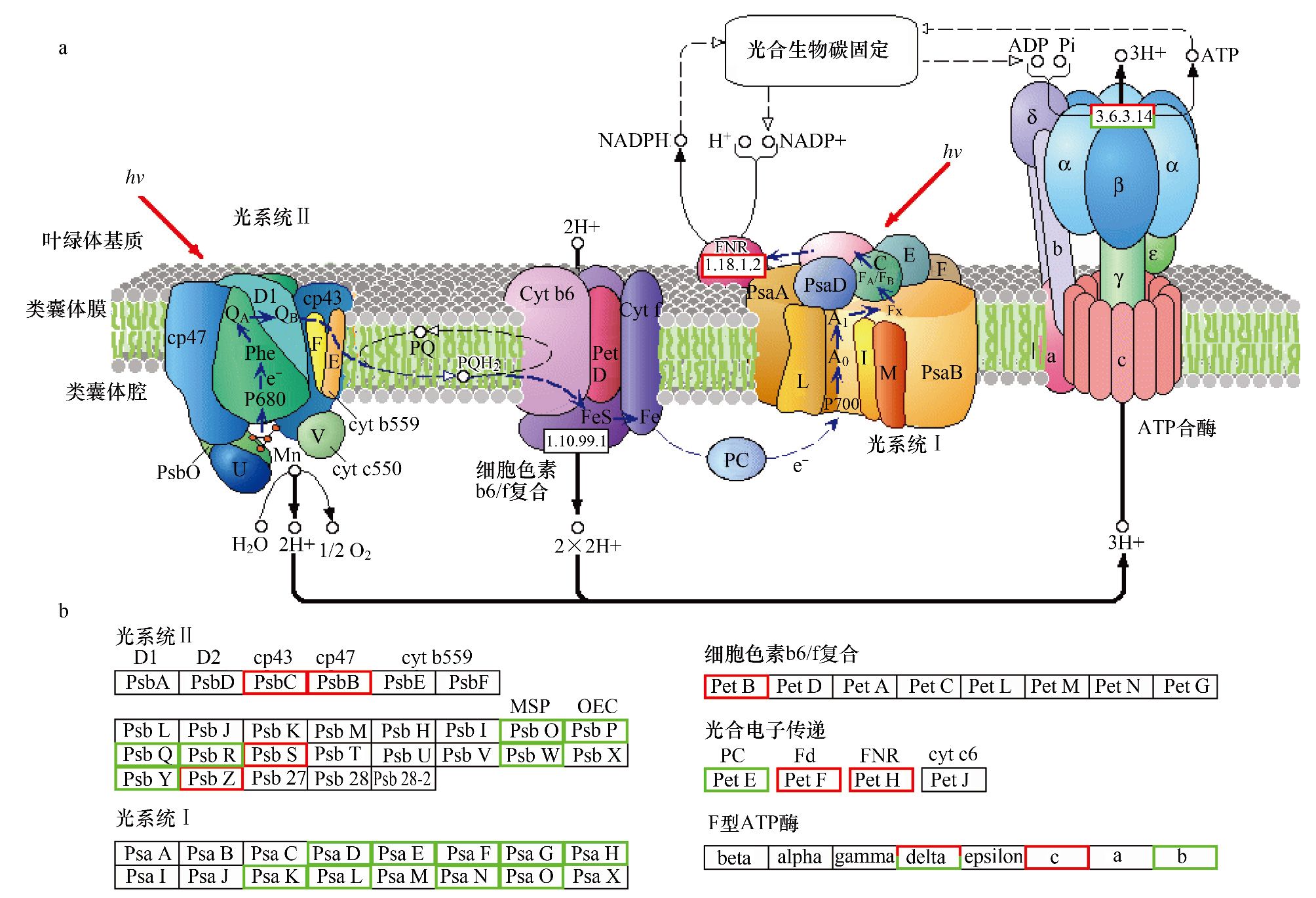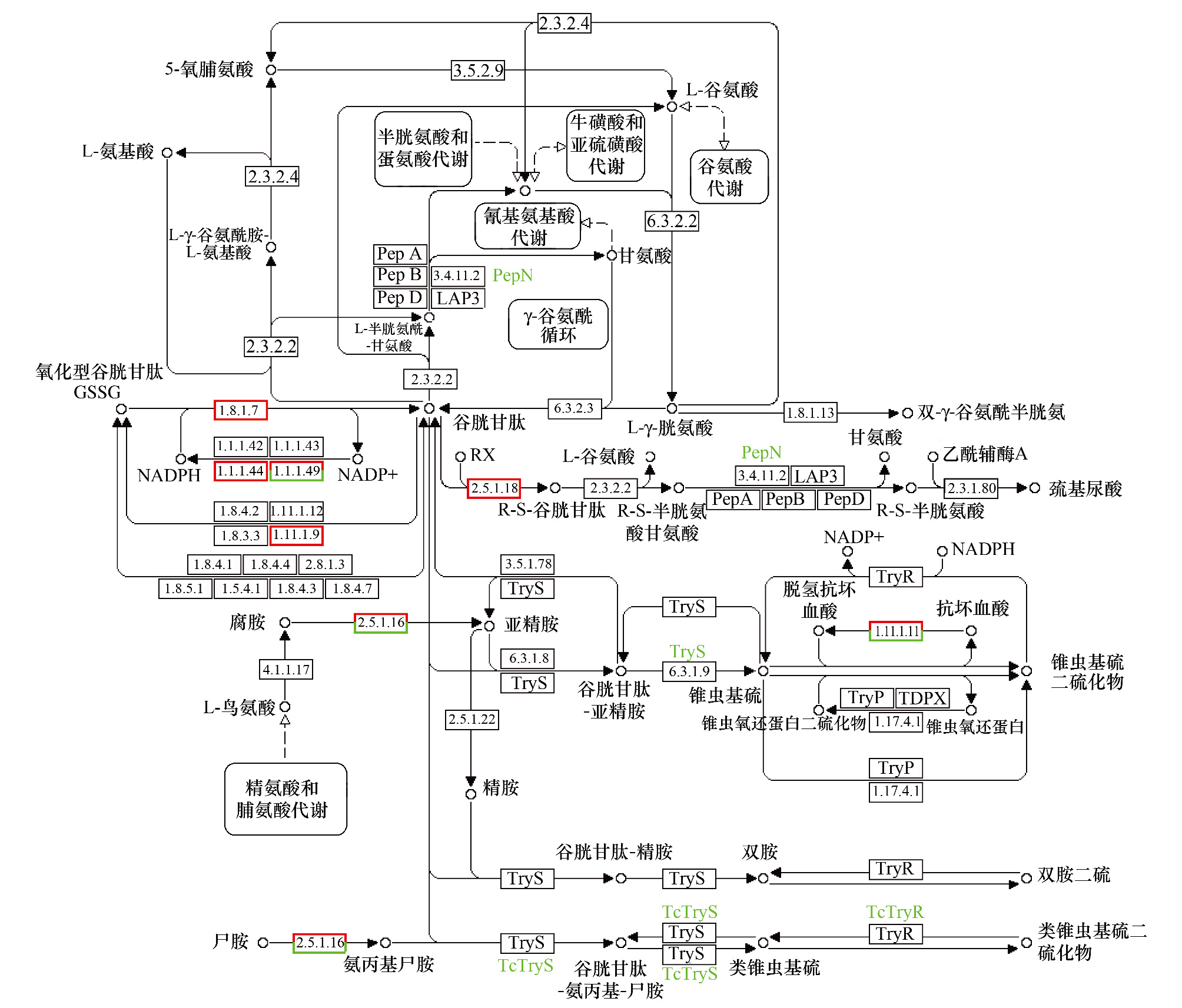文章信息
- 崔翠, 王利鹃, 周清元, 谭尊飞, 曲存民, 张正圣
- CUI Cui, WANG Lijuan, ZHOU Qingyuan, TAN Zunfei, QU Cunmin, ZHANG Zhengsheng
- 低温胁迫下烤烟幼苗叶片光合作用和抗氧化能力基因差异表达谱
- Expression profiling of genes related to photosynthesis and antioxidant capacity in flue-cured tobacco seedlings subjected to chilling stress
- 生态学报, 2014, 34(21): 6076-6089
- Acta Ecologica Sinica, 2014, 34(21): 6076-6089
- http://dx.doi.org/10.5846/stxb201310242565
-
文章历史
- 收稿日期:2013-10-24
- 修订日期:2014-7-3
低温冷害是限制农业生产的主要因子之一。低温会使叶绿素分解,细胞受到伤害,质膜相对透性增大[1],叶绿素含量降低[1, 2, 3, 4]。叶绿体是低温胁迫的直接目标[5],低温削弱植物通过光合作用利用光能的能力[6, 7, 8]。植物在一定低温范围内通过提高保护酶含量来维持体内自由基产生与清除间的动态平衡。若低温胁迫严重,就会导致自由基含量增高,造成膜脂过氧化,丙二醛含量上升,细胞膜系统受到伤害[9]。温度逆境也诱导植物本身具有的抗氧化物质,如过氧化物酶、过氧化氢酶、超氧化物歧化酶、谷胱甘肽及抗坏血酸等含量上升来抵御逆境伤害[1, 10]。
生物对各种生物、理化及致病因子的应答,本质上都是基因差异表达的结果。比较同一类细胞或不同类细胞在不同生理状态或生长发育阶段下的基因表达差异,对研究生物生长发育调控及代谢机制具有重要意义[11]。近年来,利用mRNA 差异显示技术和基因芯片技术等研究逆境对作物生长发育的影响取得了重要进展,对作物逆境生理和遗传育种研究发挥了积极作用[12, 13, 14, 15, 16]。高通量测序的数字化基因表达谱(Digital gene expression profile,DGE)技术是新发展起来的分析生物转录组基因表达的方法,能更加真实、全面地评价细胞中全部基因的表达情况,也能够检测未知基因的表达,是发现新基因的一种有效方法[17, 18]。在转录水平上对外界非生物胁迫下植物应答机制的研究主要集中在拟南芥、水稻等植物上,胁迫类型以干旱、冷害、盐胁迫等为主[19, 20, 21, 22, 23]。关于烟草在低温胁迫下基因的特异表达研究较少,本研究模拟南方烟区“倒春寒”,研究低温胁迫对烤烟幼苗光合能力、膜氧化及抗氧化能力的影响,再通过高通量的数字化基因表达谱技术,分析低温胁迫下烤烟幼苗抗寒相关基因的差异表达谱,寻找低温胁迫后与烟草光合作用、抗氧化能力有关的功能基因,为深入分析烟草低温胁迫伤害机理、挖掘抗寒相关基因,提高烟草适应性栽培等方面提供理论指导。
1 材料与方法 1.1 材料培养与处理试验材料为生产上大面积栽培的Msk326(K326),由云南烟草科学研究所选育。选取大小一致且饱满的烤烟种子浸种催芽出苗后,分别移栽于装有营养土的塑料钵内,在3叶期选取大小基本一致烟苗,每钵定苗3株,置于光照培养箱中培养生长。培养条件:温度为23—25 ℃;光照强度为6000 lx,每日光照12 h。烟苗长至5—6片真叶时,5—7 ℃低温胁迫处理3 d(标记为B),常温23—25 ℃培养为对照(标记为A)。取其相同部位叶片进行RNA提取和相关生理指标测定。
总RNA提取试剂盒为WASON(RNAex Reagent System Ⅳ)试剂盒,上海华舜生物工程有限公司生产,其它均采用国产分析纯试剂。
1.2 试验方法 1.2.1 生理生化指标测定取处理(B)和对照(A)叶片,参考崔翠方法[24],分别测定总叶绿素Chl 含量,Chl a 及Chl b含量,Pn,Gs,Tr,Ci,电解质渗透率,Pro及MDA含量,POD、CAT和SOD活性,GSH及Vc含量等生理指标。每处理4次重复,测定数据利用Micorsoft excel 软件进行处理,利用DPS统计软件进行差异显著性检验。
1.2.2 低温胁迫后烤烟幼苗叶片基因差异表达谱的分析RNA提取方法参考试剂盒操作手册进行,分别取对照(A)和处理(B)叶片混合成两个样品池,从两个样品池中各取混合烟叶叶片组织0.5 g左右,提取6 μg总RNA,-78 ℃保存。测序由深圳华大基因科技有限公司承担。采用边合成边测序法(Sequencing by synthesis,SBS)测序[25]。测序所得原始图像数据经base calling 转化为序列数据。对测序得到的原始标签去除3′adaptor 序列、低质量序列(含未知碱基)以及长度过小或过大,拷贝数为1的tag,确定Clean tag。对初步筛选获得的Clean tags进行标准化处理[26],统计不同tag的分布特征,分析测序饱和度。将Clean tags 与基因序列进行比对,确定Clean tag 代表的基因。通过tags 统计相应基因的表达量。
从NCBI网站检索mRNA Unigene序列上所有CATG位点,生成CATG+17碱基的参考标签数据库。将全部clean tags与参考标签数据库比对,允许最多1个碱基错配,对其中唯一比对到1个基因的标签(Unambiguous tags)进行基因注释,统计每个基因对应的原始的clean tag数目,然后对原始clean tag数做标准化处理,获得标准化的基因表达量,衡量基因的表达水平。标准化的方法为:每个基因包含的原始clean tag 数/该样本中总clean tag 数×1000000[26]。参照Audic S.等发表在Genome Research上的数字化基因表达谱差异基因检测方法[17]。
参考李余良等方法[15]把所有差异表达基因向GO(Gene ontology)数据库(http://www.genetntology.org/)的各个项目映射,找出与整个Tag库背景相比,在差异表达基因中显著富集的GO条目和显著性富集的Pathway,分析其中与光合及抗氧化能力相关的差异表达基因。
2 结果与分析 2.1 低温胁迫处理对烤烟幼苗叶片部分光合能力和抗氧化指标的影响叶绿素与光合作用密切相关,同时也是衡量植物抗寒力高低的一项重要指标。结果如表 1所示,低温处理3 d后的叶绿素含量,无论是叶绿素a (Chl a)还是叶绿素b (Chl b)含量均显著下降,说明低温胁迫严重阻碍了叶绿素合成;低温处理后烤烟叶片光合能力降低,低温导致净光合速率、气孔导度、蒸腾速率显著下降。氧自由基的积累对细胞存在着巨大伤害,处理3 d后烤烟幼苗叶片电解质渗透率、脯氨酸含量及丙二醛含量均显著上升,说明低温胁迫已对烤烟幼苗叶片细胞膜造成一定伤害,但其氧自由基生成速率(形成速率)显著下降;另外,膜保护酶中CAT及SOD活性显著上升,而POD活性则显著下降;抗氧化物质Vc和GSH含量均显著上升。从结果来看,低温胁迫3 d后,K326幼苗叶片光合能力下降,细胞膜氧化,但其自身抗氧化能力显著提升。低温处理3d后烤烟K326幼苗在光合能力、膜氧化及抗氧化能力方面均发生显著变化。
| 主要生理生化指标 The physiological and biochemical parameters | 对照 CK | 处理 treatment | 增幅/% range of increasing |
| *表示差异显著(P<0.05) | |||
| 光合能力 Photosynthetic capacity | |||
| 叶绿素含量 Chlorophyll contents/(mg/g) | 0.74 | 0.71 | -4.05* |
| 叶绿素a 含量Chla contents/(mg/g) | 0.52 | 0.51 | -2.88* |
| 叶绿素b 含量Chlb contents/(mg/g) | 0.22 | 0.21 | -6.82* |
| 净光合速率 Pn/(μmol m-2 s-1) | 2.02 | 0.64 | -68.50* |
| 叶片气孔导度 Gs/(mmol m-2 s-1) | 0.05 | 0.04 | -20.91* |
| 胞间二氧化碳浓度 Ci/(μmol mol-1) | 329.59 | 329.10 | -0.15 |
| 蒸腾速率 Tr/(mmol m-2 s-1) | 1.52 | 1.30 | -14.14* |
| 膜氧化及抗氧化Membrane oxidation and antioxidant | |||
| 脯氨酸含量Proline content/(mg g-1 min-1) | 21.03 | 51.35 | 144.22* |
| 丙二醛 MDA content/(μmol/g) | 5.03 | 5.23 | 3.88* |
| 电解质渗透率Electrolyte permeability/% | 0.39 | 0.44 | 12.82* |
| 氧自由基生成速率Oxyradical Generation rate/(nmol mg-1 min-1) | 3.47 | 3.10 | -10.66* |
| SOD活性SOD content/(U g-1 min-1) | 60.42 | 64.09 | 6.07* |
| CAT活性CAT content/(U g-1 min-1) | 2.41 | 3.51 | 45.64* |
| POD活性 POD content/(△470 g-1 min-1) | 5.15 | 4.90 | -4.95* |
| Vc含量 Vc content/(mg/100g | 56.90 | 169.20 | 197.36* |
| GSH含量 GSH content/(μg/g) | 127.26 | 145.27 | 14.15* |
分别提取低温胁迫(B)及常温培养(A)的烤烟幼苗叶片的总RNA,样品经NANODrop 2000C 核酸检测仪检测,OD260/OD280均在1.8—2.2范围内,纯度较高。按照检测的浓度,将相同处理的总RNA等量混合。用DNase I降解基因组DNA,电泳显示RNA均保持完整性。总RNA用电泳检测表明,28S rRNA和18S rRNA条带清晰可见,无拖带现象,说明RNA完整性较好,可满足实验要求。
测序得到对照样品A 和处理样品B 原始序列数据,经去除杂质后得到高质量tag(Clean tag)分别有3490430条和3506495条,占总tag数的95.91%和94.69%;仅有5%左右的tag拷贝数小于2或只有接头序列。通过测序分析,最终得到的clean tag的数量均达到总测序量90%以上,说明样品制备和测序质量良好。对2个样品Clean tag拷贝数分布进行分析,显示拷贝数大于100的高表达Tags 在对照和处理中分别占63.79%和55.50%,在数量上占绝对优势; 拷贝数小于5的低表达Tags虽然在总拷贝数中分别只占5.94%和7.24%,但是在种类上非常丰富,均达到57%以上,从整体上评估测序数据正常。
从NCBI网站上(http://www.ncbi.nlm.nih.gov/)下载和烟草相关的参考基因有24432条,参考tag有74261条。通过软件检索Unigene上所有CATG位点,生成CATG+17碱基的参考标签数据库,其中参考基因中有CATG位点的基因有22263个,唯一的参考标签有72259个。将clean tags分别与参考标签数据库比对,并统计每个基因对应clean tag的数目。对照(A)一个tag完全比对上一个基因的标签(允许1个碱基错配)数目为1066364,占总数的30.55%,种类为16983种,占总数的13.47%;而处理(B)一个tag完全比对上一个基因的标签(允许1个碱基错配)数目为889559,占总数的25.37%,种类为18619,占总数的12.03%。
2.2.2 低温胁迫后烤烟幼苗叶片基因表达谱分析经过Unigene标签库进行基因注释后,通过基因比对,设定FDR≤0.001[25],且倍数差异在2倍以上(∣log2 ratio∣≥1)作为阈值来分析判断基因在2个温度状态下是否差异表达,筛选出差异表达基因。低温胁迫后(处理B)与对照A相比较(图 1),有2357个基因发生了显著的差异表达,其中有1673个基因表达上调,log2 ratio值大于10的有62个,5.00 — 9.99之间的有185个,1.00 — 4.99之间有1426个;684个基因表达下调,log2 ratio值小于 -10的有11个,-9.99— -5.00之间的有51个,-4.99— -1.00之间的有622个。

|
| 图 1 低温胁迫下烤烟幼苗差异表达基因 Fig. 1 Differentially expressed genes (DEGs) of leaves of tobacco seedling under chilling stress |
通过GO功能富集分析(Gene ontology,简称GO),对差异表达显著的基因进行功能分类注释(图 2)。图 2结果表明,从差异表达基因所处的细胞位置来看,低温胁迫后烤烟幼苗与对照烟苗发生显著差异表达的基因主要集中在光合系统(Photosystem)、光合膜(Photosynthetic Membrane)、类囊体(Thylakoid Part)、叶绿体(Chloroplast)、质体(Plastid Part)、细胞质(Cell Plastid)、细胞膜(Membrane)等位置,其中与细胞质有关基因发生差异表达最为显著,有524个基因发生差异表达,占总差异表达基因的45.1%;与生物膜有关的差异表达基因达到420个,占总差异表达基因的36.1%;细胞器部分,差异表达基因达到358个,占总差异表达基因的30.8%;此外,质体及细胞内细胞器部分等位置差异表达基因亦均达到27%以上。从分子功能分析结果看,低温胁迫导致烤烟幼苗基因的氧化还原能力、跨膜运输能力、结构分子活力发生显著改变。其中与氧化还原能力相关基因差异最为显著,差异表达基因达到196个,占总差异表达基因的16.3%;与跨膜运输能力相关的差异表达基因为104个,占总差异表达基因的8.6%;在结构分子活力方面,差异表达基因达到74个,占总差异表达基因的6.1%。发生显著差异表达的生物过程主要集中在胁迫响应、代谢物质及能源的初始反应、光合及光反应,对激素刺激的细胞响应、激素调节的信号途径等方面。其中胁迫刺激响应的生物过程差异最为显著,差异表达基因达到426个,占总差异表达基因的36.3%;与温度胁迫响应相关差异表达基因为223个,占总差异表达基因的19.0%;与先导代谢物及能源相关差异表达基因74个,占总差异表达基因的6.3%。因此,从差异基因所处的位置、分子功能和影响的生物过程来看,调控烤烟幼苗光合作用和抗氧化能力的基因在低温胁迫后发生了较大的差异表达,为进一步分析提供了基础。

|
| 图 2 低温胁迫下烤烟幼苗叶片表达基因的功能分类 Fig. 2 Classification on functional of differentially expressed genes of leaves of tobacco seedling under chilling stress |
在生物体内,不同基因相互协调行使其生物学功能,基于Pathway的分析有助于进一步了解基因的生物学功能。KEGG是有关Pathway的主要公共数据库[27],以KEGG Pathway为单位,应用超几何检验,进行Pathway显著性富集分析,在Qvalue≤0.05时,低温对光合天线蛋白(捕光色素蛋白复合体,light-harvesting chlorophyll protein complex,简写LHC)和光合能力影响差异显著。参照Kanehisa laboratories的光合作用天线蛋白示意图 3 (a),标记显著差异基因于图 3(b),并将对应的差异表达基因列于表 2。从图 3(b)和表 2来看,光系统Ⅰ(photosystem Ⅰ,简写PSⅠ)和光系统Ⅱ(photosystem Ⅱ,简写PSⅡ)中部分捕光叶绿素a/b色素天线蛋白(Lhca1、Lhca2、Lhca3、Lhca4、Lhca5、Lhcb1、Lhcb2、Lhcb3、Lhcb4、Lhcb5)等均在低温胁迫下发生显著下调。说明低温胁迫导致烤烟幼苗对光电子的捕获能力下降。

|
| 图 3 KEGG数据库中光合作用-天线蛋白示意图(a); 低温胁迫下烤烟幼苗与光合天线蛋白相关差异表达基因(b) Fig. 3 The skechmap of antenna proteins related photosynthesis in KEGG database(a); Differential expression genes related photosynthesis-antenna proteins of tobacco seedling under chilling stress(b) 绿色方框代表表达基因下调 |
| 基因登ID gene ID | log2ratio | 假定功能 Putative function | 蛋白 Protein |
| CAA45523.1 | -3.85 | photosystem I light-harvesting chlorophyll a/b-binding protein | Lhca1 |
| AAA34140.1 | -3.14 | chlorophyll a/b-binding protein | Lhca1 |
| P10708.1|CB12_SOLLC | -3.74 | chlorophyll a-b binding protein 7,chloroplastic | Lhca2 |
| 226872|prf||1609235A | -2.63 | chlorophyll a/b binding protein | Lhca3 |
| CAK24966.1 | -4.9 | chlorophyll a/b binding protein | Lhca4 |
| XP_002284724.1 | -3.41 | predicted: hypothetical protein | Lhca5 |
| XP_002893588.1 | -3.93 | hypothetical protein ARALYDRAFT_473203 | Lhcb1 |
| P27495.1|CB24_TOBAC | -3.52 | chlorophyll a-b binding protein 40,chloroplastic | Lhcb1 |
| P27493.1|CB22_TOBAC | -3.72 | chlorophyll a-b binding protein 21,chloroplastic | Lhcb1 |
| P27492.1|CB21_TOBAC | -4.03 | chlorophyll a-b binding protein 16,chloroplastic | Lhcb1 |
| P07369.1|CB2G_SOLLC | -4.69 | chlorophyll a-b binding protein 3C,chloroplastic | Lhcb1 |
| P27494.1|CB23_TOBAC | -4.45 | chlorophyll a-b binding protein 36,chloroplastic | Lhcb2 |
| ABG73416.1 | -2.91 | chloroplast pigment-binding protein CP24 | Lhcb2 |
| AAO62942.1 | -3.78 | chlorophyll a/b binding protein | Lhcb2 |
| AAO62942.1 | -3.47 | chlorophyll a/b binding protein | Lhcb2 |
| P27489.1|CB23_SOLLC | -4.16 | chlorophyll a-b binding protein 13,chloroplastic | Lhcb3 |
| ABG73415.1 | -4.17 | chloroplast pigment-binding protein CP29 | Lhcb4 |
| ABG73417.1 | -3.47 | chloroplast pigment-binding protein CP26 | Lhcb5 |
| ABG73416.1 | -3.94 | chloroplast pigment-binding protein CP24 | Lhcb6 |
参照Kanehisa laboratories的光合作用示意图 4(a),将差异表达基因分别标记在图 4(b),并将对应基因列于表 3。表 3结果表明,低温胁迫后烤烟幼苗与光合作用有关的差异表达基因有35个,其中11个基因表达上调,24个基因表达下调。从图 4(b)和表 3来看,在PSⅡ上,上调表达的基因主要有影响PSⅡ中核心编码蛋白CP47及分子量为44kDa、22kDa等蛋白质相关的基因,这些基因主要控制光合作用中叶绿体类囊体上PsbC、PsbB、PsbS和PsbZ等蛋白;在下调表达的基因中,部分调节PSⅡ中水裂解酶、水氧化蛋白及分子量为10kDa的多肽等相关基因表达下调,导致PSⅡ中6个核心编码蛋白(PsbO、PsbP、PsbQ、PsbR、PsbW和PsbY)表达下调;下调表达基因部分降低PSⅠ亚基(PSⅠ-D1、PSⅠ-H、Ⅲ)的前体及PSⅠ反应中心亚基(Ⅱ、IX A、X psaK、XI、XIB)的生成,因此,导致PSⅠ中有9个核心编码蛋白(PsaD、PsaE、PsbF、PsaG、PsaH、PsaK、PsbL、PsaO和PsaN)相关基因均在转录表达水平上显著下调。细胞色素b/f复合物 (Cytochrome b6-f complex) 是类囊体膜上可分离出来的多亚基膜蛋白。在本研究中,控制光合电子传递的细胞色素b6/f复合物的部分基因Cytb6发生了上调表达(PetB蛋白表达上调)、与光合电子传递链有关的蛋白PetF、PetH上调,而PetE蛋白下调。此外,ATP合成酶复合体有关的基因c蛋白基因上调,b蛋白基因下调及ATP合成酶(如ATP合酶δ链,ATP合酶c链)发生上调表达。总之,在光合作用中下调表达的24个基因中,涉及到光合作用的原初反应、光合电子链的传递、光合磷酸化、光合碳同化等主要的代谢通路;部分基因的上调表达,也提高了烤烟幼苗对低温胁迫的适应。

|
| 图 4 KEGG数据库中光合作用示意图(a);低温胁迫下烤烟幼苗与光合作用相关的差异表达基因(b) Fig. 4 The skechmap of photosynthesis in KEGG database(a); Differential expression genes related photosynthesis of tobacco seedling under chilling stress(b) 红色方框表示基因上调 |
| 基因登ID gene ID | log2ratio | 假定功能 Putative function | 图中位置Position |
| O04397.1|FENR2_TOBAC | 1.109 | ferredoxin-NADP reductase,root-type isozyme, chloroplastic | 1.18.1.2 |
| XP_002271630.1 | -1.1 | predicted: hypothetical protein | 3.6.3.14/b |
| BAH11228.1 | 2.725 | ATP synthase CF0 C chain | 3.6.3.14/c |
| XP_002523293.1 | 2.194 | ATP synthase delta chain,putative | 3.6.3.14/DeltA |
| P32980.1|ATPD_TOBAC | -1.9 | ATP synthase delta chain,chloroplastic | 3.6.3.14/DeltA |
| YP_001936513.1 | 2.333 | photosystem II 44 kDa protein | PsbC |
| ADD30625.1 | 11.42 | photosystem II CP47 chlorophyll apoprotein | PscB |
| AAP03871.1 | -3.54 | oxygen evolving complex 33 kDa photosystem II protein | PsbO |
| CAA45699.1 | -4.42 | 23 kDa polypeptide of water-oxidizing complex of photosystem II | PsbP |
| CAA44292.1 | -4.31 | 23-kDa ploypeptide of photosystem II oxygen- evolving complex | PsbP |
| P18212.2|PSBP2_TOBAC | -2.43 | oxygen-evolving enhancer protein 2-2,chloroplastic; | PsbP |
| XP_002279556.1 | -1.38 | predicted: hypothetical protein | PsbP |
| BAD97359.1 | -3.33 | PsbQ | PsbQ |
| AAU03361.1 | -2.65 | photosystem II oxygen-evolving complex protein 3 | PsbQ |
| Q40519.1|PSBR_TOBAC | -1.78 | photosystem II 10 kDa polypeptide,chloroplastic; S | PsbR |
| Q9SMB4.1|PSBS_TOBAC | 1.039 | recName: Full=Photosystem II 22 kDa protein,chloroplastic | PsbS |
| ACU13646.1 | -3.49 | unknown | PsbW |
| XP_002285325.1 | -2.02 | predicted: hypothetical protein | PsbY |
| YP_001109497.1 | 3.512 | hypothetical protein Poptr_cp018 | PsbZ |
| BAA02871.1 | -3.74 | PSⅠ-D1 precursor | PsaD |
| P29302.1|PSAD_NICSY | -2.64 | photosystem Ⅰ reaction center subunit Ⅱ,chloroplastic; | PsaD |
| Q41228.1|PSAEA_NICSY | -3.43 | photosystem Ⅰ reaction center subunit chloroplastic; | PsaE |
| Q41229.1|PSAEB_NICSY | -2.71 | photosystem Ⅰ reaction center subunit Ⅳ B,chloroplastic | PsaE |
| AAP03872.1 | -4.11 | putative photosystem Ⅰ subunit Ⅲ precursor | PsaF |
| CBI39855.3 | -2.2 | unnamed protein product | PsaG |
| BAA04634.1 | -3.62 | PSⅠ-H precursor | PsaH |
| AAP03873.1 | -3.15 | photosystem I reaction center subunit X psaK | PsaK |
| AAO85557.1 | -2.87 | photosystem I subunit Ⅺ | PsaL |
| ACZ72945.1 | -3 | photosystem I reaction center subunit | PsaN |
| CAB75430.1 | -5.3 | putative 16kDa membrane protein | PsaO |
| P06247.2|CYB6_TOBAC | 4.362 | cytochrome b6 | PetB |
| ACV32157.1 | -2.64 | chloroplast plastocyanin precursor | petE |
| ACU15698.1 | 5.601 | unknown | PetF |
| XP_002275771.1 | 1.1 | predicted: hypothetical protein isoform 2 | PetF |
| O04397.1|FENR2_TOBAC | 1.1 | ferredoxin-NADP reductase,root-type isozyme, chloroplastic | PetH |
5 —7 ℃低温胁迫后K326烤烟幼苗代谢通路中,谷胱甘肽代谢途径是基因显著差异表达显著富集的最主要生化代谢途径之一。结合KEGG数据库中谷胱甘肽代谢图将差异基因标注在图 5,并将相关基因信息列于表 4。表 4结果表明,低温诱导烤烟幼苗谷胱甘肽代谢过程差异表达基因共有26个,其中上调表达的基因有23个,3个基因下调表达。上调表达的基因主要是与谷胱甘肽-s-转移酶(GSTs)、抗坏血酸过氧化物酶、磷脂过氧化氢酶、谷胱甘肽过氧化物酶、6-磷酸葡萄糖酸盐脱氢酶等酶蛋白有关的基因。其中,与谷胱甘肽S-转移酶(GST)相关的基因有13个发生了上调表达,占总上调表达基因的50.00%;谷胱甘肽二硫化物和谷胱甘肽之间的代谢过程中差异基因8个,占总差异基因的29.63%,其中,APIC基因(基因登录号为P46440.1|GSTF2_TOBAC)上调表达最显著,较对照上升近1000倍,C-7(基因登录号为CAA45741.1)上调表达达到500倍,均在清除细胞内活性氧及保护细胞抵御活性亲电物质时起重要作用。

|
| 图 5 低温胁迫下烤烟幼苗的谷胱甘肽代谢过程中的差异表达基因 Fig. 5 Differential expression genes related to glutathione metabolism of tobacco seedling under chilling stress |
| 基因登ID gene ID | log2ratio | 假定功能Putative function | 图中位置Position |
| ACN35899.1 | 1.578 | unknown | 1.1.1.44 |
| XP_002530803.1 | 1.801 | 6-phosphogluconate dehydrogenase,putative | 1.1.1.44 |
| CAA04992.1 | 3.75 | glucose-6-phosphate dehydrogenase | 1.1.1.49 |
| CAA04994.1 | -3.11 | glucose-6-phosphate dehydrogenase | 1.1.1.49 |
| P80461.1|GSHRP_TOBAC | 1.335 | glutathione reductase,chloroplastic | 1.8.1.7 |
| AAL35365.1|AF442387_1 | 1.048 | ascorbate peroxidase | 1.11.1.11 |
| ABX79340.1 | 1.838 | cytosolic ascorbate peroxidase | 1.11.1.11 |
| BAA12918.1 | 1.343 | cytosolic ascorbate peroxidase | 1.11.1.11 |
| Q9THX6.1|TL29_SOLLC | -1.74 | thylakoid lumenal 29 kDa protein,chloroplastic | 1.11.1.11 |
| Q9FXS3.1|GPX4_TOBAC | 2.54 | probable phospholipid hydroperoxide glutathione peroxidase; | 1.11.1.9 |
| XP_002276256.1 | 1.008 | predicted: hypothetical protein | 1.11.1.9 |
| CAE54353.1 | -1.96 | putative spermine synthase | 2.5.1.16 |
| O48660.1|SPDE_NICSY | 2.48 | spermidine synthase; Putrescine aminopropyltransferase | 2.5.1.16 |
| AAX20044.1 | 2.075 | probable glutathione-S-transferase | 2.5.1.18 |
| ABQ96852.1 | 1.13 | glutathione S-transferase | 2.5.1.18 |
| ADB85103.1 | 2.78 | glutathione S-transferase omega | 2.5.1.18 |
| CAA45741.1 | 8.741 | glutathione S-transferase C-7 | 2.5.1.18 |
| CAJ13709.1 | 2.54 | glutathione S-transferase 12 | 2.5.1.18 |
| CBI15230.3 | 3.867 | unnamed protein product | 2.5.1.18 |
| CBI32040.3 | 2.066 | unnamed protein product | 2.5.1.18 |
| P25317.1|GSTXA_TOBAC | 3.37 | probable glutathione S-transferase parA | 2.5.1.18 |
| P46440.1|GSTF2_TOBAC | 9.642 | glutathione S-transferase APIC | 2.5.1.18 |
| P49332.1|GSTXC_TOBAC | 2.404 | probable glutathione S-transferase parC; | 2.5.1.18 |
| Q03666.1|GSTX4_TOBAC | 3.794 | probable glutathione S-transferase; PCNT107 | 2.5.1.18 |
| XP_002305918.1 | 1.858 | predicted protein | 2.5.1.18 |
| XP_002509786.1 | 1.094 | glutathione-s-transferase theta,gst,putative | 2.5.1.18 |
烟草生长最适温度为25— 28 ℃。目前,烤烟大多采用工厂化集约漂浮育苗,虽然育苗小环境有所改善,但受自然气温影响仍然很大,当温度降至12 ℃以下会造成出苗慢、降低出苗率及苗期生长缓慢。南方很多烟区在早春育苗阶段常有“倒春寒”等低温危害发生,一般3 d左右,有时甚至达1周,影响烟苗质量及移栽后还苗期延长,最终影响烟叶生产中、上等烟的比例及优质特色烟叶生产。晋艳等研究了低温胁迫0.5—1.5 h后2个烟草品种(云烟85和K326)幼苗的膜透性、脯氨酸含量、膜保护酶和叶绿素含量变化特点[5],模拟南方烟区“倒春寒”特点,低温胁迫3 d后测定烤烟幼苗光合能力、膜氧化和抗氧化能力,研究结果对烤烟壮苗培育具有重要参考意义。本研究结果表明,低温胁迫后其叶绿素含量、光合能力显著下降,细胞膜受损,结果与短时间处理[5]结果一致,但膜保护酶活性和抗氧化物质(谷胱甘肽和抗坏血酸)含量显著上升,抗氧化能力加强,植物本身耐低温能力得到提高。植物在逆境胁迫响应下受到多个基因的调控,在逆境条件下大量基因表达发生变化,这些基因对相应逆境耐性的获得起到重要作用[15]。基于测序技术的数字化基因表达谱具有高通量和高灵敏性的优势,不需要获得目标基因序列,可以从全基因组突破同时研究成千上万个基因的表达,能很好反映生物在生长发育过程中整个基因组的基因表达变化情况[27, 28]。因此,我们采用该基因表达谱分析技术分析低温处理3 d后烤烟幼苗叶片的基因差异表达情况,从中进一步验证基因表达差异和光合能力、抗氧化能力之间的一致性,发现大量的上调和下调差异表达基因,其中部分基因表达量较高,为进一步利用这些基因提供了理论依据。
在高等植物中大部分的叶绿素分子都结合在PSⅠ和PSⅡ的天然色素蛋白复合物上,类囊体膜是光合作用能量转换所需的脂质双层膜,含有捕光及将光能转化为化学能所必需的色素蛋白及酶系统。其中,PSⅡ捕光色素蛋白复合物在类囊体膜上的含量最为丰富,它所结合的叶绿素约占类囊体膜上色素量的50%[29]。通常PSⅠ捕光色素蛋白 (LHC)含有Lhca1、Lhca2、Lhca3 和Lhca4等种蛋白质,PSⅡ捕光色素蛋白 (LHCII)含有Lhcb1、Lhcb2、Lhcb3、Lhcb4、Lhcb5等蛋白质,捕光色素蛋白分子量在20 — 29 kD 之间[30]。内囊体膜中有两种捕光天线叶绿素a/b色素蛋白复合体,PSⅠ捕光天线叶绿素a/b 色素蛋白复合体 (LHCI) 和PSⅡ捕光天线叶绿素a/b色素蛋白复合体 (包括LHCII、CP29 、CP26 、CP24 和CP22)。由于LHCII 结合有叶片叶绿素总量的50%,在光合作用光能的吸收中具有重要作用。CP29、CP26、CP24 和CP22是PSⅡ捕光天线叶绿素a/b色素蛋白复合体中4种主要的亚复合物,含有β-胡萝卜素和叶黄素,参与叶黄素循环,分散过多的激发能,对抗光抑制,起到保护反应中心的作用,其中CP22和CP29更靠近PSⅡ核心复合物。本研究结果表明,低温胁迫后叶绿素a/b结合蛋白编码基因,无论是CP22还是CP29,表达都下调,说明低温胁迫后叶片叶绿素捕光能力下降。光合作用的原初反应,即捕光色素分子吸收光能,将能量快速高效地传递给光合作用反应中心,进行电荷分离,固定激发能,经过一系列电子传递步骤,将能量转化为电化学自由能。PSⅡ反应中心负责光能的转换、电子和质子的产生以及分子氧的释放过程的启动。叶绿体PsbA和PsbD 基因编码的D1和D2多肽是PSⅡ RC 的主要功能蛋白,它们结合着P680,脱镁叶绿素a和 β-胡罗卜素,并且含有PSⅡ电子传递链中最重要的组分Z 和D,还为与水裂解相关的锰簇提供结合位点[31]。CP47 和CP43 与反应中心的D1 和D2 蛋白紧密相连,除了将外周天线叶绿素a/b结合蛋白(LHCII、CP29、CP27、CP24、CP22)捕获的激发能汇集给反应中心外,还具有核心天线的作用。本研究发现,低温胁迫后烟草CP47(PsbB)和CP43 (PsbC) 相关基因表达明显上调,可能是为了适应天线蛋白基因下调的结果,起到一种补偿作用。光合作用的开始是从PSⅠ开始。PSⅠ是电子传递链过程,从初级接受者(Primary acceptor)开始,经过铁氧化还原蛋白(Fd)、细胞色素复合体(Cytochrome Complex)、质体蓝蛋白(含铜蛋白质)(Pc)后再回到PSⅠ,本文中PSⅠ相关调控差异基因均表现为下调表达,说明低温影响电子链的传递。光合电子传递是由反应中心启动,由电荷分离所导致的,由PSⅡ和PSⅠ串联起来进行的,其中细胞色素b6/f复合物位于PSⅡ和PSⅠ两者之间。本文中低温导致烤烟细胞色素b6/f复合物上调,光电子传递部分基因上调,部分基因下调,这也可能是烤烟幼苗低温适应的结果。叶绿素含量高低变化是光合作用重要的影响因素,也会影响叶片对光能的吸收。低温胁迫3d后烤烟K326多数叶绿素相关基因处于下调,同时,叶绿素含量较对照显著下降,研究结果表明叶绿素总含量变化和作为两种捕光天线叶绿素a/b色素蛋白复合体基因下调是相对一致的。同时,K326在低温处理后,其净光合速率、蒸腾速率、叶片气孔导度等均显著下降,说明其光合能力大大下降,与基因表达谱分析结果一致。
谷胱甘肽是一种在生物体内广泛存在的活性三肽,具有作为药物、机体异物的解毒剂、机体抗氧化剂、氨基酸运输物质、辅酶等各种生化作用[32]。尤其是可自发地或在GPX(谷胱甘肽过氧化物酶)催化下来清除体内的活性氧,也可通过谷胱甘肽硫转移酶(GST)催化形成GSX来清除活性物质以保护细胞,降低氧化损伤[33]。低温处理K326后进行基因差异表达分析结果显示,葡萄糖-6-磷酸脱氢酶、精胺合酶、叶绿体类囊体29kDa蛋白等蛋白质有关的基因均处于下调表达,说明有机体有一套强大的自我保护及调控机制来应对环境胁迫。谷胱甘肽相关基因的上调及下调表达是其更充分发挥抵御氧化压力及解毒功能的作用,这种调控与自我保护机制密切相关。本文通过测定K326烟草幼苗叶片中自由基生成速率发现,低温处理3 d后自由生产速率下降,从差异基因表达情况来看,谷胱甘肽相关基因多处于上调(表 3),这和自由基生产速率下降一致。本文谷胱甘肽上调基因中,主要包含谷胱甘肽S转移酶、多胺(亚精胺合酶,腐胺氨丙基转移酶)及抗坏血酸过氧化物酶等类型,均与抵御逆境胁迫有关。谷胱甘肽和Vc含量在低温处理后显著上升,说明K326烤烟幼苗通过相关基因上调,提高了其清除自由基能力。林元震[34]通过将克隆的葡萄糖-6-磷酸脱氢酶(G6PDH)基因转移到烟草中进行低温胁迫后发现,随着胁迫时间延长,转化烟草的SOD、POD活性升高而MDA含量下降,说明该基因在烟草中的表达有助于膜保护性酶SOD和POD活性提高及细胞膜稳定,进而提高了转基因烟草的耐低温能力[34]。通过低温胁迫处理K326后,其CAT酶活性上升,SOD酶活性显著上升,POD酶活性则表现为显著下降,这可能与差异基因表达谱中G-6-PD基因中部分上调、部分处于下调有关。
植物对低温胁迫的响应是植物体内一个复杂的过程,主要包括感应低温信号,信号转导,及引起转录因子与相关功能性基因的差异表达。植物主要通过气孔关闭、渗透性物质积累、活性氧清除以及对膜和蛋白结构的保护等一系列反应作为对低温胁迫的耐受响应。本研究差异表达基因涉及到烤烟幼苗对低温胁迫响应机制的各个方面。此外,还有大量功能未知基因,这些基因参与多种代谢途径,功能表达多表现为上调,少数表达下调,部分呈现超过10倍的表达量,这些基因与烤烟幼苗在低温胁迫下的生理生态反应将是下一步研究的主要内容之一。本研究也获得了一批与耐寒相关的基因,尤其是抗氧化相关的超量表达基因,为耐寒基因克隆及分子机理研究奠定了基础。
| [1] | Liang H M, Xia Y, Du F, Zhang P J. Effect of low temperature stress on physiological process of kentucky bluegrass. Acta Agrestia Sinica, 2001, 9(4): 283-286. |
| [2] | Wang Y, Yang H F, Li S D. Studies on chilling injury and cold hardiness of horticultural crops. Acta Horticulturae Sinica, 1994, 21(3): 239-244. |
| [3] | Yan Q, Ma Y S, Shi J J, Wang Y L, Yang S H. Effect of low temperature stress on physiological process of three kinds of herbage grasses in the seedling stage. Journal of Qinghai University: Natural Science, 2007, 25(1): 54-57. |
| [4] | Strand M, Oquist G. Effects of frost hardening, dehardening and freezing stress on in vivo fluorescence of seedlings of Scots pine (Pin sylvestris L.). Plant Cell and Environment, 1988, 11(4): 231-238. |
| [5] | Jin Y, Yang Y H, Hua S J, Duan Y Q, Cheng X Y. Effects of low temperature stress on the protective enzymes and contents of nitrogen and carbon compounds of tobacco seedlings. Journal of Southwest China Normal University: Natural Science Edition, 2007, 32(3): 74-79. |
| [6] | Hart J J, Stemler A. High light-induced reduction and low light-enhanced recovery of photon yield in triazine-resistant Brassica napus L. Plant Physiology, 1990, 94(3): 1301-1307. |
| [7] | Zhou J, Yang L F, Hao F G, You Y. Photosynthesis and chlorophyll-fluorescence of magnolia grandiflora seedlings under low temperature stress. Acta Botanica Boreali-Occidentalia Sinica, 2009, 29(1): 136-142. |
| [8] | Wu X X, Chen J L, Zha D S. Effects of low temperature stress on chlorophyll fluorescence characteristics and excitation energy dissipation in eggplant seedling leaves. Plant Nutrition and Fertilizer Science, 2009, 15(1): 164-169. |
| [9] | Chen H H, Li D H. Plant Cold Hardness and Freezing Stress. Vol. 2. New York: Academy Press, 1982: 5-15. |
| [10] | Prasad T K. Role of catalase in inducing chilling tolerance in pre-emergent maize seedling. Plant Physiology, 1997, 114(4): 1369-1376. |
| [11] | Liang P, Pardee A B. Differential display of eukaryotic messenger RNA by means of the polymerase chain reaction. Science, 1992, 257(5072): 967-971. |
| [12] | Nikiforova V, Freitag J, Kempa S, Adamik M, Hesse H, Hoefgen R. Transcriptome analysis of sulfur depletion in Arabidopsis thaliana: interlacing of biosynthetic pathways provides response specificity. The Plant Journal, 2003, 33(4): 633-650. |
| [13] | Wang R, Guegler K, LaBrie S T, Crawford N M. Genomic analysis of a nutrient response in Arabidopsis reveals diverse expression patterns and novel metabolic and potential regulatory genes induced by nitrate. The Plant Cell, 2000, 12(8): 1491-1509. |
| [14] | Zou Z W, Fang W P, Zhang D, Duan Y S, Li X H. Analysis of differential expression genes in cold-induced tea plant. Journal of Tea Science, 2008, 28(4): 249-254. |
| [15] | Li Y L, Liu J H, Zheng J R, Hu J G. Gene expression profile of sweet corn ears under heat stress. Acta Agronomica Sinica, 2013, 39(2): 269-279. |
| [16] | Zhu S Q, Ji B H, Chen M W, Chen Y H, Zhou R, Liang J S. Expression profiling of rice transcription factor genes under salt or low temperature stress. Bulletin of Science and Technology, 2010, 26(6): 844-852. |
| [17] | Audic S, Claverie J M. The significance of digital gene expression profiles. Genome Research, 1997, 7(10): 986-995. |
| [18] | Ansorge W J. Next-generation DNA sequencing techniques. New Biotechnology, 2009, 25(4): 195-203. |
| [19] | Fowler S, Thomashow M F. Arabidopsis transcriptome profiling indicates that multiple regulatory pathways are activated during cold acclimation in addition to the CBF cold response pathway. Plant Cell, 2002, 14(8): 1675-1690. |
| [20] | Kaplan F, Kopka J, Sung D Y, Zhao W, Popp M, Porat R, Guy C L. Transcript and metabolite profiling during cold acclimation of Arabidopsis reveals an intricate relationship of cold-regulated gene expression with modifications in metabolite content. The Plant Journal, 2007, 50(6): 967-981. |
| [21] | Li L L, Wang F R, Han J M, Dong J G. Screening of drought-sensitive mutant in Arabidopsis thaliana and responses of drought-sensitive mutant to drought stress. Journal of Agricultural University of Hebei, 2011, 34(4): 35-40. |
| [22] | Seki M, Narusaka M, Abe H, Kasuga M, Yamaguchi-Shinozaki K, Carninci P, Hayashizaki Y, Shinozaki K. Monitoring the expression pattern of 1300 Arabidopsis genes under drought and cold stresses by using a full-length cDNA microarray. Plant Cell, 2001, 13(1): 61-72. |
| [23] | Yamaguchi T, Nakayama K, Hayashi T, Yazaki J, Kishi-moto N, Kikuchi S, Koike S. cDNA microarray analysis of rice anther genes under chilling stress at the microsporo-genesis stage revealed two genes with DNA transponson castaway in 5'-flanking region. Bioscience Biotechnology, Biochemmistry, 2004, 68(6): 1315-1323. |
| [24] | Cui C. Studies on physiological ecological response and gene difference expression of flue-cured tobacco seedlings in chilling stress [D]. Chongqing: Southwest University, 2012. |
| [25] | Benjamini Y, Yekutieli D. The control of the false discovery rate in multiple testing under dependency. The Annals of Statistics, 2001, 29(4): 1165-1188. |
| [26] | Morrissy A S, Morin R D, Delaney A, Zeng T, McDonald H, Jones S, Zhao Y, Hirst M, Marra M A. Next-generation tag sequencing for cancer gene expression profiling. Genome Research, 2009, 19(10): 1825-1835. |
| [27] | Kanehisa M, Araki M, Goto S, Hattori M, Hirakawa M, Itoh M, Katayama T, Kawashima S, Okuda S, Tokimatsu T, Yamanishi Y. KEGG for linking genomes to life and the environment. Nucleic Acids Research, 2008, 36(Database issue): D480-484. |
| [28] | Hao Q N, Zhou X A, Sha A H, Wang C, Zhou R, Chen S L. Identification of genes associated with nitrogen-use efficiency by genome-wide transcriptional analysis of two soybean genotypes. BMC Genomics, 2011, 12: 525-525. |
| [29] | Xiang T H, Wang L L, Pang J L. Cloning and characterization of a full-length cab gene encoding the lightharvesting chlorophyll a/b-binding proteins in rice (Oryza Sativa L.). Acta Agronomica Sinica, 2005, 31(9): 1227-1232. |
| [30] | Green B R, Pichersky E, Kloppstech K. Chlorophyll a/b binding proteins: an extended family. Trends Biochemical Sciences, 1991, 16(5): 181-186. |
| [31] | Nanba O, Satoh K. Isolation of a photosystem II reaction center consisting of D-1 and D-2 polypeptides and cytochrome b-559. Proceedings of the National Academy of Sciences of the United States of America, 1987, 84(1): 109-112. |
| [32] | Mao Z, Qiu J P. Main physiological function and metabolic modulation of glutathione in yeast. Journal of Microbiology, 2005, 25(1): 94-96. |
| [33] | Jelinsky S A, Samson L D. Global response of saccharomyces cerevisiaeto an alkylating agent. Proceedings of the National Academy of Sciences of the United States of America, 1999, 96(4): 1486-1491. |
| [34] | Lin Y Z, Zhang Z Y, Guo H, Liu C X, Chen X Y. Isolation and analysis of glucose-6-phosphate dehydrogenase (G6PDH) promoter from poplar. Genomics and Applied Biology, 2009, 28(3): 445-449. |
| [1] | 梁慧敏,夏阳,杜峰,张普金.低温胁迫对草地早熟禾抗性生理生化指标的影响.2001,9(4):283-286. |
| [3] | 严青,马玉寿,施建军,王彦龙,杨时海.低温胁迫对3种牧草幼苗抗性生理指标的影响.青海大学学报(自然科学版),2007,25(1):54-57. |
| [5] | 晋艳,杨宇虹,华水金,段玉琪,程新宇.低温胁迫对烟草保护性酶类及氮和碳化合物的影响.西南师范大学学报(自然科学版),2007,32(3): 74-79. |
| [7] | 周建,杨立峰,郝峰鸽,尤扬.低温胁迫对广玉兰幼苗光合及叶绿素荧光特性的影响.西北植物学报,2009,29(1):136-42. |
| [8] | 吴雪霞, 陈建林, 查丁石.低温胁迫对茄子幼苗叶片叶绿素荧光特性和能量耗散的影响.植物营养与肥料学报,2009,15(1): 164-169. |
| [14] | 邹中伟, 房婉萍, 张定, 段云裳, 黎星辉. 低温胁迫下茶树基因表达的差异分析. 茶叶科学, 2008, 28(4): 249-254. |
| [15] | 李余良, 刘建华, 郑锦荣, 胡建广. 高温胁迫下甜玉米雌穗发育基因差异表达谱分析. 作物学报, 2013, 39(2): 269-279. |
| [16] | 朱素琴, 季本华, 陈名蔚, 陈艳红, 周蓉, 梁建生. 高盐低温胁迫下水稻转录因子基因表达谱分析. 科技通报, 2010, 26(6): 844-852. |
| [21] | 李琳琳, 王凤茹, 韩建民, 董金皋. 拟南芥干旱敏感突变体的筛选及其对干旱胁迫的响应. 河北农业大学学报, 2011, 34(4): 35-40. |
| [24] | 崔翠. 低温胁迫下烤烟幼苗的生理生态响应及基因差异表达研究 [D]. 重庆: 西南大学, 2012. |
| [29] | 向太和, 王利琳, 庞基良. 水稻(Oryza sativa L.)捕光叶绿素a/b结合蛋白基因全长cDNA的克隆和特性分析. 作物学报, 2005, 31(9): 1227-1232. |
| [32] | 毛珍, 裘娟萍. 酵母菌中谷胱甘肽的主要生理功能及其代谢调控. 微生物学杂志, 2005, 25(1): 94-96. |
| [34] | 林元震, 张志毅, 郭海, 刘纯鑫, 陈晓阳. 杨树葡萄糖-6-磷酸脱氢酶(G6PDH)基因启动子的克隆与分析. 基因组学与应用生物学, 2009, 28(3): 445-449. |
 2014, Vol. 34
2014, Vol. 34




